
Prepared for Health Canada
Prepared by Narrative Research
PSPC Contract Number: HT372-224172
Contracted Value: $43,363.75
Contract Date: 2022-05-30
Delivery Date: 2022-08-25
POR number: 008-22
For more information, please contact: cpab_por-rop_dgcap@hc-sc.gc.ca
Ce rapport est aussi disponible en français
Executive Summary
Supplier Name: Narrative Research
August 2022
This public opinion research report presents the results of focus groups conducted by Narrative Research on behalf of Health Canada. The research entailed a total of six online focus groups with males in physically demanding professions in targeted communities located in each of six regions: British Columbia (BC), Alberta/Prairies, Ontario, Quebec, Atlantic, and Northern territories/regions. Participants had current or past employment in designated physically demanding occupations (primarily construction trades) and were between the ages of 20 and 59. All sessions included a mix of cultural backgrounds, including Indigenous representation, and only those living in market for at least two years were invited to take part. The Quebec session was conducted in French while all other discussions were held in English. The research was conducted between July 28 and August 3, 2022.
Cette publication est aussi disponible en français sous le titre :
Mise à l’essai de messages et de documents créatifs sur la réduction de la stigmatisation et des méfaits liés aux opioïdes
This publication may be reproduced for non-commercial purposes only. Prior written permission must be obtained from Health Canada. For more information on this report, please contact Health Canada at: cpab_por-rop_dgcap@hc-sc.gc.ca
Catalogue Number:
H14-413/2022E-PDF
International Standard Book Number (ISBN):
978-0-660-45290-6
Related publications (registration number: POR-008-22):
Catalogue Number H14-413/2022F-PDF (Final Report, French)
ISBN 978-0-660-45291-3
© His Majesty the King in Right of Canada, as represented by the Minister of Health, 2022
Narrative Research Inc.
Contract Number: HT372-224172
POR Registration Number: 008-22
Contract Award Date: 2022-05-30
Contracted Cost: $43,363.75
With the significant increase in apparent opioid toxicity deaths since the beginning of the COVID-19 pandemic, Health Canada is in the process of developing a new creative concept and visual identity as part of the Department’s multi-year marketing campaign to address the growing opioid overdose crisis. As part of the campaign development, a new creative concept with a new visual identity is being considered as part of targeting a particular audience (rather than the broader audience of young- to middle-aged men in Canada that were targeted in previous campaigns). The campaign aims to:
In this context, Health Canada was interested in testing the creative concepts developed as part of this marketing campaign, to determine which concept resonates most with the targeted audiences. More specific research objectives included:
To achieve these objectives, a qualitative research approach was undertaken. This entailed a total of six online focus groups conducted between July 28 and August 3, 2022 in specific communities located across six regions: British Columbia (Vancouver, Thompson-Caribou, Fraser), Prairies (Medicine Hat, Edmonton, Calgary, various communities in Saskatchewan and Manitoba), Ontario (Thunder Bay, Sudbury, Toronto, Guelph, Ottawa), Quebec (Montreal and Québec City), Atlantic Canada (Fredericton, Moncton, Halifax), and various communities in Northern Territories or northern regions of provinces. In each region, one focus group was conducted with males aged 20 to 59 who work currently or formerly in physically demanding professions (predominantly in the construction sector). Sessions included a mix of cultural backgrounds, including Indigenous representation.
Each session lasted between 90 minutes and two hours and all group discussions were held in English except for one in Quebec which was conducted in French. Participants were provided an incentive of $125. Across all groups, a total of 59 individuals were recruited and 45 participated.
All participants were recruited per the recruitment specifications for the Government of Canada. Recruitment was conducted through qualitative panels stored on Canadian servers, with follow-up calls to confirm the details provided and to ensure quotas were met.
This report presents the findings from the study. Caution must be exercised when interpreting the results from this study, as qualitative research is intended to be directional only. Results cannot be attributed to the overall population under study, with any degree of confidence.
I hereby certify as a Representative of Narrative Research that the deliverables fully comply with the Government of Canada political neutrality requirements outlined in the Directive on the Management of Communications. Specifically, the deliverables do not include information on electoral voting intentions, political party preferences, standings with the electorate or ratings of the performance of a political party or its leaders.
Signed 
Margaret Brigley, CEO & Partner | Narrative Research
Date: August 25, 2022
The following summarizes the key findings and conclusions from the Stigma and Opioid Harm Reduction Creatives and Message Focus Testing research study. Key findings and conclusions are presented below for each creative concept discussed during the focus groups. There is appreciation for an awareness campaign to address substance use and addiction among men, especially given the perceived prevalence of the situation in the construction and trades sectors.
Video Concepts
Three video concepts were each presented and discussed one at a time.
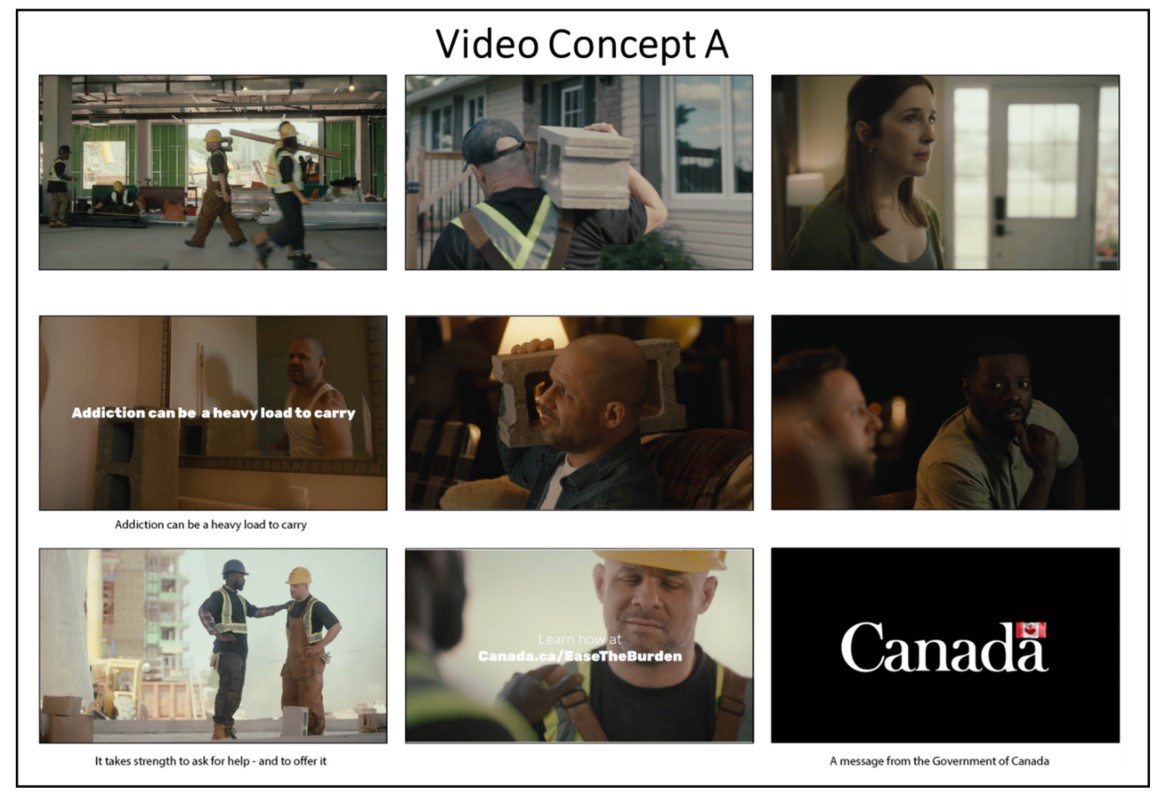
This video concept highlights the heavy burden of addiction and the strength required to seek or offer help needed by those struggling with substance use.
Concept A emphasized the visuals by using the least amount of voice-over (aka narration). The voice-over was presented in 2 frames in addition to “A message from the government of Canada”.
Storyboard frames of Video Concept A (left to right, row by row)
Frame one: The main character walks past co-workers on a construction site, carrying a cinder block on his right shoulder.
Frame two: The main character walks home while still carrying the cinder block on his shoulder.
Frame three: The main character’s partner notices the cinder block, looks concerned and physically attempts to remove the burden. He shifts the cinder block from one shoulder to another while dismissing the offer of support.
Frame four: The main character inspects heavy bruising on his shoulder in the mirror while the cinder block is still nearby. His pain is displayed through his reflection. Text appears on screen and the voice-over reads “Addiction can be a heavy load to carry”.
Frame five: The main character attends a casual private gathering with friends and co-workers, watching TV in a garage. The main character is watching TV while still carrying the cinder block on his shoulder.
Frame six: One of the main character’s co-workers notices the burden with concern when everyone else jumps up and cheers.
Frame seven: The main character and the concerned co-worker are back on the job site. The co-worker extends and places a compassionate hand on the shoulder of the main character. The cinder block is set down on the floor. The voice-over says: “It takes strength to ask for help – and to offer it.”
Frame eight: The main character looks relieved, and the compassionate hand is still visible on the shoulder. Text appears on screen “Canada.ca/EaseTheBurden”
Frame nine: The Canada wordmark appears and the voice-over reads “A message from the Government of Canada”
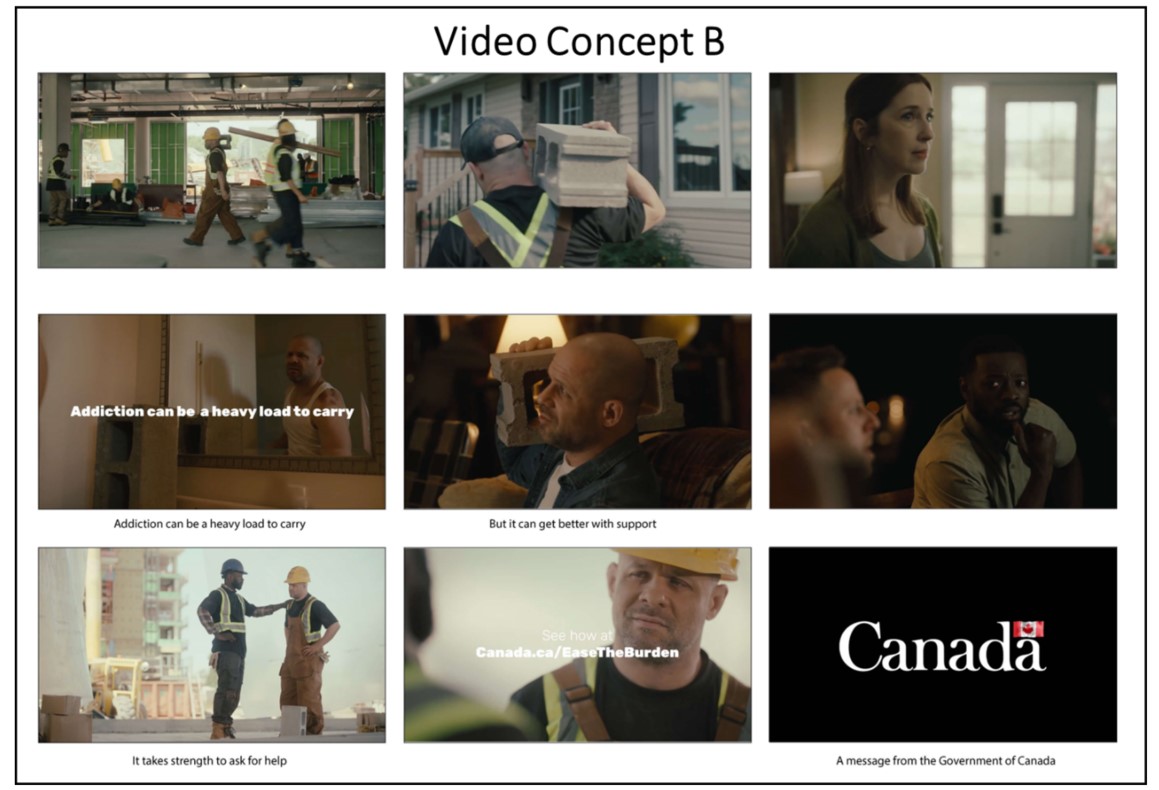
This video concept highlights the heavy burden of addiction and reassures that it can get better with support. Concept B uses more voice-over than concept A. The voice-over was presented in 3 frames in addition to “A message from the government of Canada”.
Storyboard frames of Video Concept B (left to right, row by row)
Frame one: The main character walks past co-workers on a construction site, carrying a cinder block on his right shoulder.
Frame two: The main character walks home while still carrying the cinder block on his shoulder.
Frame three: The main character’s partner notices the cinder block, looks concerned and physically attempts to remove the burden. He shifts the cinder block from one shoulder to another while dismissing the offer of support.
Frame four: The main character inspects heavy bruising on his shoulder in the mirror while the cinder block is still nearby. His pain is displayed through his reflection. Text appears on screen and the voice-over reads “Addiction can be a heavy load to carry”.
Frame five: The main character attends a casual private gathering with friends and co-workers, watching TV in a garage. The main character is watching TV while still carrying the cinder block on his shoulder. The voice-over says, “But it can get better with support.”
Frame six: One of the main character’s co-workers notices the burden with concern when everyone else jumps up and cheers.
Frame seven: The main character and the concerned co-worker are back on the job site. The co-worker extends and places a compassionate hand on the shoulder of the main character. The cinder block is set down on the floor. The voice-over says, “It takes strength to ask for help.”
Frame eight: The main character looks relieved, and the compassionate hand is still visible on the shoulder. Text appears on screen: “See how at Canada.ca/EaseTheBurden”
Frame nine: The Canada wordmark appears and the voice-over reads “A message from the Government of Canada.”
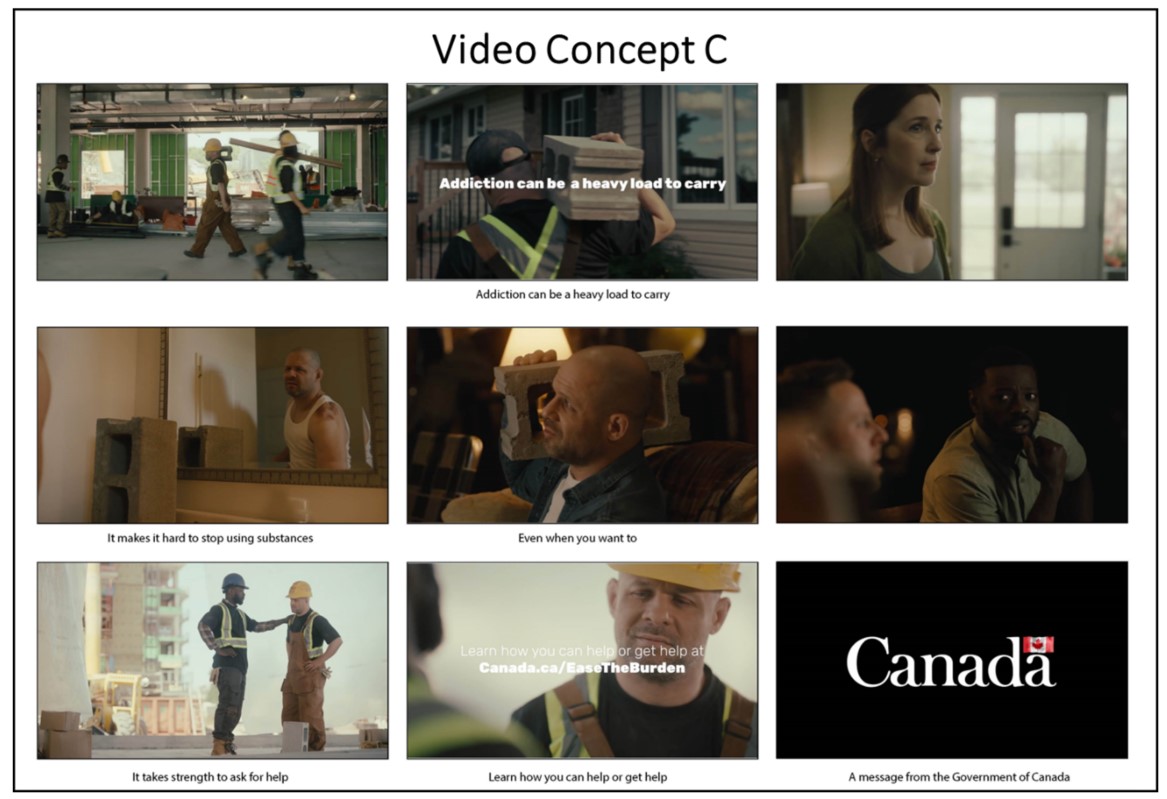
This video concept highlights the heavy burden of addiction and acknowledges the obstacles in overcoming addiction despite a desire to do so.
Concept C uses the most voice-over. The voice-over was presented in 5 frames in addition to “A message from the government of Canada”.
Storyboard frames of Video Concept C (left to right, row by row)
Frame one: The main character walks past co-workers on a construction site, carrying a cinder block on his right shoulder.
Frame two: The main character walks home while still carrying the cinder block on his shoulder. Text appears on screen and the voice-over reads “Addiction can be a heavy load to carry”.
Frame three: The main character’s partner notices the cinder block, looks concerned and physically attempts to remove the burden. He shifts the cinder block from one shoulder to another while dismissing the offer of support.
Frame four: The main character inspects heavy bruising on his shoulder in the mirror while the cinder block is still nearby. His pain is displayed through his reflection. The voice-over says, “It makes it hard to stop using substances.”
Frame five: The main character attends a casual private gathering with friends and co-workers, watching TV in a garage. The main character is watching TV while still carrying the cinder block on his shoulder. The voice-over says, “Even when you want to.”
Frame six: One of the main character’s co-workers notices the burden with concern when everyone else jumps up and cheers.
Frame seven: The main character and the concerned co-worker are back on the job site. The co-worker extends and places a compassionate hand on the shoulder of the main character. The cinder block is set down on the floor. The voice-over says, “It takes strength to ask for help.”
Frame eight: The main character looks relieved, and the compassionate hand is still visible on the shoulder. Text appears on screen, “Learn how you can help or get help at Canada.ca/EaseTheBurden”. The voice-over says, “Learn how you can help or get help.”
Frame nine: The Canada wordmark appears and the voice-over says, “A message from the Government of Canada.”
Regardless of the specific concept, the video overall is effective at grabbing attention and at presenting the seriousness of the situation and the negative impact of addiction issues. The use of the cinder block representing the weight of addiction provides strong imagery that establishes personal relevance, while effectively conveying the burden addiction takes on someone’s life. At the same time, the video provides a sense of hope that help is available. The familiar scenarios and the emotional charge make the approach relevant to people working in the trades and the general message is considered credible and using the right tone. That being said, none of the three video concepts tested has a strong call-to-action. While the message of seeking or offering help is clear, the way this can be achieved is unclear. As such, making the URL more prominent, improving the contrast of the on-screen text on the last frame, and speaking it out loud were suggested ways to achieve that, along with ensuring that the type of information or support available online is clearly specified. The primary audience is viewed as people experiencing addiction.
Some of the reactions were more specific to each video concept. Notably, limiting the on-screen text and voice-over (aka narration) in Video Concept A contributed to the dramatic effect that grabbed attention, and allowed viewers to relate based on their personal interpretation of the situation featured. Speaking of addiction also broadened the appeal to include a variety of workplace issues related to mental health and addiction (e.g., stress, anxiety, workplace, workplace safety) which was appreciated by some, despite causing message confusion.
While still presenting addiction more broadly, Video Concept B introduces the notion of assistance more strongly. In terms of speaking of addiction broadly, the same message confusion reported with Video Concept A is also experienced with Concept B. That said, specifying that addiction can get better with support introduces a stronger sense of hope and implies a positive outcome is possible. The primary audience continues to be those experiencing addiction.
Video Concept C has greater message clarity in speaking of substance use specifically, and speaking to both those seeking help and people around them. Introducing the topic upfront helped clarify the video’s intent. That said, increased narration (on-screen and voice-over) reduced the dramatic effect and as a result, the video’s ability to command attention. The primary audience was considered those who have substance use issues.
After reviewing all video concepts, participants were asked to select which one is most effective at achieving different things. While Video Concept C is viewed as having the clearest message given the additional information provided and the specific reference to substance use, none of the video concepts clearly outperforms the others in terms of being personally compelling or inspiring action. There is also a variety of opinions regarding personal preference. Based on these findings, it is suggested that Video Concept C be further developed with some changes. Most notably, consideration should be given to provide clearer direction as to where help is available or what resources can be accessed (for example by putting more emphasis on the URL or being more specific in terms of the type of information or support available) and to enhance gender diversity shown on the worksite.
Call-to-Action
The three call-to-action statements presented in the video concepts were discussed on their own, without the related creative. Overall reactions are more strongly positive towards the statement C and as such, the call-to-action “Learn how you can help or get help at Canada.ca/EaseTheBurden (Découvrez comment offrir ou obtenir de l’aide à : Canada.ca/AllegeonsLeFardeau)” should be included in the campaign for its ability to convey a specific action and for inviting those who are living with an addiction and those around them to take action. The call-to-action Concept A (Learn how at Canada.ca/EaseTheBurden (Apprenez comment à : Canada.ca/AllegeonsLeFardeau) was felt to lack in direction, while the call-to-action Concept B (Make it easier for yourself and others. See how at Canada.ca/EaseTheBurden (Allégez votre fardeau et celui des autres. Découvrez comment à : Canada.ca/AllegeonsLeFardeau) was too long and believed to wrongly imply that dealing with addiction is easy. While the first sentence of the call-to-action Concept B elicited negative reactions, the use of “see how” in the statement was preferred over the use of “learn how” from other call-to-action statements. The idea of learning implied a more time-consuming search and review of information than the level of effort participants want to invest.
Audio Assets
Two concepts for an audio ad that could be used online or on radio were presented and discussed one at a time, prior to participants choosing their preferred option. Reactions to Audio Concept 2 were generally more favourable for its ability to grab attention through the use of a variety of audio cues (different voices; background workplace noises; use of silence) and conveyance of the seriousness of the topic. Combined with the script and the slower tempo, it contributed to effectively convey the intended message. By contrast, Audio Concept 1 was felt to provide too much information, too quickly and in a monotone way to command attention and be memorable, which also made it difficult to identify the main message. Consideration should be given to further develop Audio Concept 2, although to avoid further stigmatization, reference to the construction industry should be replaced by a reference to trades more generally when finalizing the audio assets.
Digital Display

A storyboard with the title, “Digital Display Option 1,” is written immediately above three side-by-side frames. The frames include text overlaid on the background images and the frames will be animated to cycle through the frames sequentially.
Frame one: A man working in a physically demanding job carrying a cinder block on his shoulder. White text appears on top of the photo and says: “Addiction can be a heavy load to carry.”
Frame two: A co-worker extends a compassionate hand to a co-worker. Text overlaid in yellow says: "But it can get better with help.”
Frame three: Same co-workers from frame 2 has a yellow background overlaid on the bottom part of the photo with a black button and white text that says, “Help or get help now.” The Government of Canada signature and the Canada wordmark are shown at the bottom of the frame.
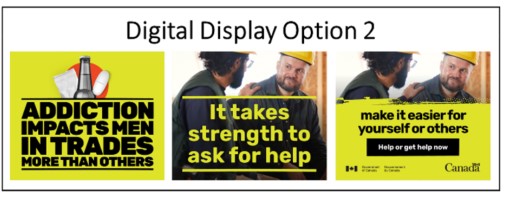
A storyboard with the title, “Digital Display Option 2,” is written immediately above three side-by-side frames. The frames include text overlaid on the background images and the frames will be animated to cycle through the frames sequentially.
Frame one: An illustration of a white powder in a zipper-top bag, the top of a glass beer bottle and a pill is shown behind the text: “Addiction impacts men in trades more than others,” which is written in black over a yellow background.
Frame two: A co-worker extending a compassionate hand to a man while seated next to each other. Yellow text overlaid on the photo that says: "It takes strength to ask for help.”
Frame three: A yellow background is overlaid on top of the same photo from Frame 2, with black text over the yellow background that says: “make it easier for yourself and others.” A black button is immediately below the text with the following written in white: “Help or get help now.” Government of Canada signature and the Canada wordmark are shown at the bottom of the frame.
Two concepts for an animated digital display were presented in the form of a storyboard, with each option including three frames. Participants were informed that the ads would be clickable to reach a website. Of the two concepts presented, Digital Display Option 2 was clearly preferred and should be further developed. Participants liked that it clearly identifies that addiction impacts men in trades more than others, and that a message of hope follows (it takes strength to ask for help). That said, the final statement should be changed to ensure it does not imply that dealing with addiction is easy. Reactions to Digital Display Option 1 were lukewarm, as the message or intent of the ad is unclear, notably with respect to the type of addiction.
In finalizing the development of the digital display ads, attention should be paid to ensure some consistency in design elements, notably the font type and colour and showing the same individuals throughout the ad, as well as ensuring that the people illustrated realistically reflect construction workers. Finally, there would be merit in reminding viewers that the ad is clickable.
Social Media Posts
In five of the six focus groups, participants were asked to comment on three social media posts presented side-by-side during a brief group discussion. In general, the provision of factual information supported by statistics held high appeal, grabbed attention, provided context and contributed to making the message credible. It was helpful to explain why men in the construction industry are targeted by the campaign. In addition, referring to the trades, rather than the construction industry, spoke to a broader audience and minimized any stigma associated with the latter group.
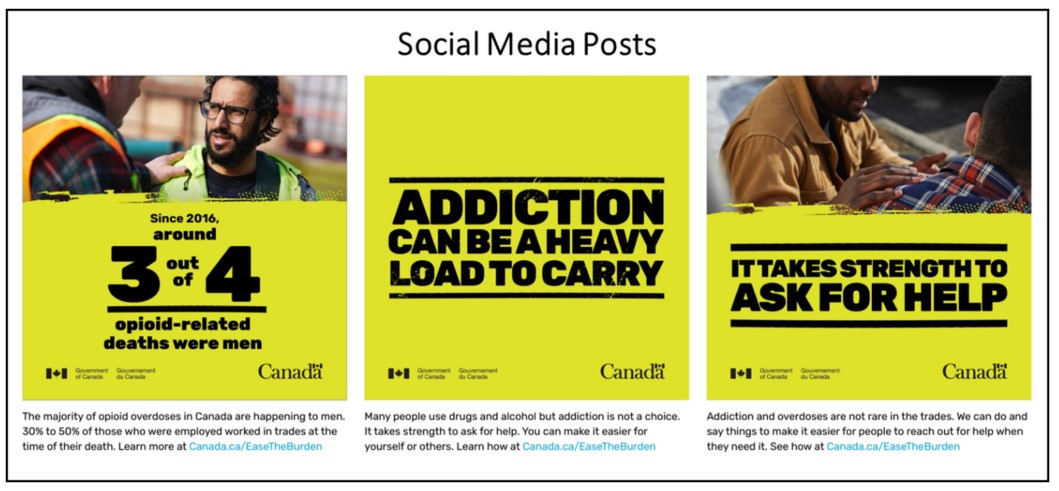
Three social media post concepts are presented with the title, “Social Media Posts” written immediately above three examples. The posts include text overlaid on the background images and the frames.
Social Media Post 1: A man in a physically demanding job extends a compassionate hand towards a co-worker’s shoulder. Text overlaid on the phot says, “Since 2016, around 3 out of 4 opioid-related deaths were men.” The Government of Canada signature and the Canada wordmark are displayed at the bottom of the graphic.
Text below the social media graphic for concept 1 says: “The majority of Opioid overdoses in Canada are happening to men. 30% to 50% of those who were employed worked in trades at the time of their death. Lean more at Canada.ca/EaseTheBurden”
Social Media Post 2: A yellow background with black text that says: “Addiction can be a heavy load to carry.” Government of Canada signature and the Canada wordmark are displayed at the bottom of the graphic.
Text below the social media graphic for concept 2 says: “Many people use drugs and alcohol but addiction is not a choice. It takes strength to ask for help. You can make it easier for yourself and others. Learn how at Canada.ca/EaseTheBurden”
Social Media Post 3: A man in a physically demanding job extends a compassionate hand toward a co-worker’s shoulder. A yellow background is added over the photo with black overlaid text that says: “It takes strength to ask for help.” Government of Canada signature and the Canada wordmark are displayed at the bottom of the graphic.
Text below the social media graphic for concept 3 says: “Addiction and overdoses are not rare in the trades. We can do and say things to make it easier for people to reach out for help when they need it. See how at Canada.ca/EaseTheBurden”